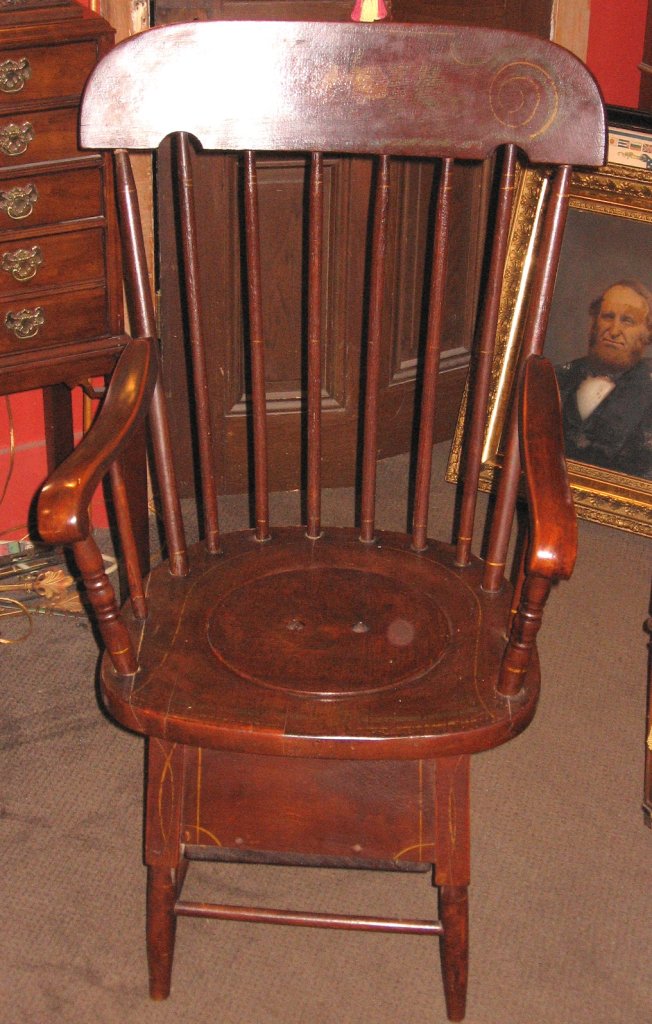As our days of outside living come to a close, it’s time to turn our attention once again to our interiors, where we and our families will spending more of our time. So that we’re all sitting pretty over the next few months, why not make this the year we notice our chairs, and see them as more than just a place to sit.
Here are some of the more important chair designs created over the last couple of centuries.
Two of the most enduring chair designs come from 18th Century. The Windsor chair (1750), with its spindle back and splayed, turned-wood legs, practically defines the classic antique. The rocking chair (1787) has been re-invented several times over the decades, most famously as the 1860s Lincoln rocker (upholstered seat and back), the late 19th Century carpet rocker (slung with a piece of rug), and the platform rocker with its stationary base.
The Hitchcock chair was the invention of Connecticut furniture maker, Lawrence Hitchcock (1795-1850). It’s a modified version of the Windsor that is painted and decorated with stencil designs.
Some chairs come into being because the invention of a new process for treating wood. The bent wood Thonet chair by the Austrian, Michael Thonet, is a classic example. Laminated wood made possible the fancy Victorian Rococo and Renaissance revival furniture from Belter in New York.
The Morris chair by the mid-19th Century Arts and Crafts guru William Morris is famously the first adjustable recliner. It’s usually found in oak, and for all its luxury, it’s rather informal looking.
George Hunsinger was a mid-19th Century German immigrant who made furniture in New York. He is known as the “father of the folding chair.” He loved contraptions, and many of his designs were avant garde for their day. Look for his “Lollipop Chair” with its disc-topped spindle back.
And finally, so many of the Modernist designers of the mid-20th Century – Breuer, Eames, Wegner, Saarinen, and others – have defined themselves by their distinctive chair designs.
These are just a few of the remarkable chair designs of the last two hundred years. Start paying attention to your old chairs, and to those in the antique shops, for artful sculptures they really are. Look for clever or historically evocative designs, with detailed carving or pure form, and fine craftsmanship.
Chair Trivia: A chair, by definition, is a movable seat with a back for a single person, and it was rather a rare thing until only about 500 years ago. We ordinary folk sat on benches, stools or storage chests. Chairs were reserved for the high mucky-mucks, kings, bishops, and aristocratic heads of households.
A bishop’s seat was called a cathedra, from which we get the word cathedral. And a king’s throne is from the word “throwne,” an old English, word meaning that the chair was handmade by various skilled craftsmen, literally “thrown together.”
The pernickety French have two words for armchair that are often heard among interior designers. An armchair with open sides is called a fauteuil (pronounced something like, “fo-toy”); an armchair with solid sides is a bergère (pronounced, “ber-zher”). The word bergère literally means shepherdess. It was assumed that an aristocratic lady could never stuff her billowy dress into a solid-sided chair, but that a lowly shepherdess wouldn’t be encumbered by such an abundance of petticoats.
Arthur Schwerdt, a certified appraiser, is the author of “The Antique Story Book: Finding the Real Value of Old Things,” and co-owner of The August Farmhouse Antiques on Route 9 in Swainton. Send your comments, questions and appraisal requests to aschwerdt@cmcherald.com.
West Wildwood – I see Sweden has cancelled the proposed windmills off their shores. This follows the overwhelming majority of fellow West Wildwood residents who have denounced the plan to place windmills along the…








